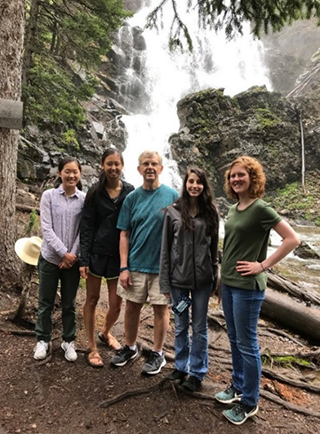
A proud Ukrainian American, Andrij Holian, Ph.D., recalls deciding to become a scientist in fifth grade. His significant contributions to the field of environmental health can be attributed to his unending curiosity and determination to always ask, “Why?”.
After receiving his Ph.D. in Chemistry from Montana State University in 1975, Holian joined the faculty at the University of Pennsylvania School of Medicine. There, his experiences sparked an interest in understanding the role of macrophages — immune system cells that help eliminate foreign substances and protect the body from infection — in lung injury.
Holian later moved to the University of Texas Houston Health Science Center, where he became Director of Research for the Mickey Leland National Urban Air Toxics Research Center.
“At the University of Texas, I had the opportunity to start connecting my interests in lung disease research, exposure assessment, and training new scientists,” Holian said. “I developed an NIEHS-funded toxicology training program in collaboration with Texas Southern University, which was among the first programs of its kind to combine the strengths of a research-intensive and Historically Black University.”
Pathways of Lung Damage from Particle Exposure
In 2000, Holian established a Center for Environmental Health Sciences (CEHS) at the University of Montana following national concern about mining operations that exposed the Libby, Montana community to toxic asbestos compounds. Since then, Holian has received several NIEHS grants to investigate how inhaling different harmful particles can cause inflammation and damage the lungs.
“Many human diseases, including Alzheimer’s disease, asthma, and cancer, can be tied to inflammation,” Holian explained. “Understanding the mechanisms behind inflammation will allow us to develop therapeutics with significant benefits for human health.”
Holian’s research focuses on health effects from exposures to engineered nanomaterials (used in a variety of industrial and commercial applications) and silica (used to make glass, stoneware, and granite countertops). In the U.S., millions of workers are exposed to silica dust, which may increase their risk of developing chronic lung diseases.
Holian was among the first researchers to demonstrate the connection between silica-induced lung injury and macrophages. While macrophages in the lungs play a key role in keeping the lung surface clean and preventing particles from accumulating, they may be susceptible to damage from silica exposure.
“First, macrophages engulf silica particles as part of the cleaning process,” Holian said. “The particle then enters the cell’s lysosome, or the ‘stomach’ of the cell whose job is to break down waste, but the lysosome cannot digest silica.”
According to Holian, silica can disrupt the lysosome’s membrane, injuring the cell and initiating inflammation. The freed silica particle may then be engulfed by another macrophage, continuing the cycle of lung damage.
Long-term exposure to silica particles, and the resulting cell injury, can result in silicosis, a lung disease caused by the buildup of scar tissue that currently has no cure. Holian hopes that by studying mechanisms of lung damage, he can mitigate the risks associated with particle exposures.
“All of these discoveries have been co-dependent on the work of my students,” Holian added. “I may not be able to personally develop a treatment for lung damage and disease, but the students I train might.”

Shaping Science at All Levels
In addition to making scientific discoveries, Holian considers his connection with students another of his greatest rewards. From elementary school students to post-doctoral researchers, he is devoted to training the next generation of scientists.
“I’m developing educational materials and graphic novels for elementary and middle school students to keep them engaged in science,” Holian said. “This is a defining point in their lives — it is important for them to maintain their curiosity.”
Holian also mentors college students by leading the University of Montana’s CEHS Summer Undergraduate Research Program, which provides students from around the country an authentic immersive experience in conducting environmental health sciences research.
Through the program, students gain critical research skills, as well as confidence and guidance to pursue graduate education.
“Our program introduces students to how critical a team approach is to solving problems,” Holian said. “I want to continue to be a strong advocate for training, education, and discovering the next important environmental health issue to address.”
Andrij Holian


